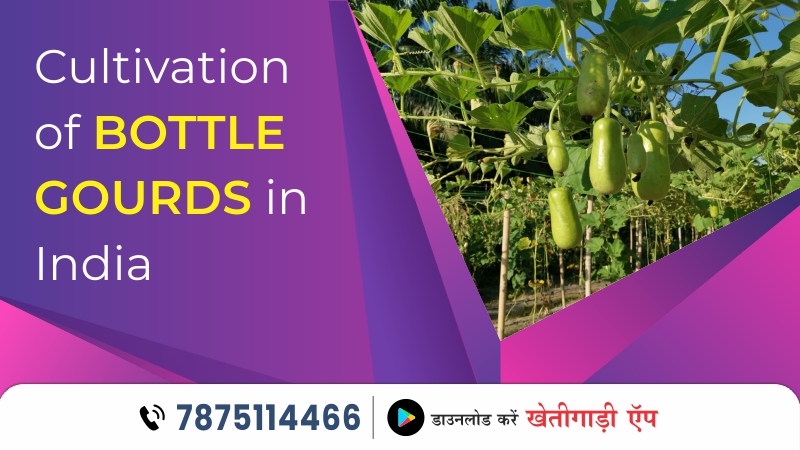One of the most significant vegetables in India is the bottle gourd, often known as “Lauki,” which is grown in practically every state. It’s also one of the most popular and profitable vegetables in Indian marketplaces. Due to old farming methods, many farmers were unable to produce a good harvest and make a profit from the bottle gourd industry. The secret to increasing the production of bottle-gourd cultivation is smart farming.
The hard-shelled fruit bottle gourd originated in tropical Africa and is now grown in warm, humid settings all over the world for a variety of uses, including as a vegetable and ornamental item. Farmers in Northern India abundantly grow it throughout the spring, summer, and rainy seasons. Because of its bottle-like shape and historical use as a container, the bottle gourd got its name.
People consume this fruit as a vegetable when it is green with leaves and a stalk. Tribal communities all over the world use its hard shells as utensils and for crafting various musical instruments. People recognize its pulp as an excellent source of fiber-free carbs. They also use it at the tender stage to create sweets and pickles. Tribal and rural villagers have utilized hard fruit shells from mature fruits as water jugs, household items, fishing net floats, and other things.
Material and Method for Bottle Gourd Cultivation:
The bottle gourd is a climbing crop that takes two to four months to mature. Its physiology includes leaves that are dark green until they are dried up from ageing, single flowers that are a pale, chalky white color, and fruits that vary in shape and size according to the variety.
Climate and Soil:
Its production requires a hot, humid atmosphere because it is a characteristic warm-season vegetable. As it cannot withstand cold, which can stunt its growth and lower its yield, the ideal night and day temperatures for its healthy growth and high fruit set are 18 to 22 °C and 30 to 35 °C, respectively. It was determined that soil made up primarily of sandy loam is best for its cultivation. Expert advised that the soil has good drainage and is rich in organic materials. It was determined that growing bottle gourds required a productive, well-drained silt loam soil.
Method of Sowing:
For the rooftop method, the ideal location should be one that makes watering and fertilizer application simple. It should be highlighted that its planting location would make it simple to pull it through a rope on the roof. Seeds can be sown at a distance of 2.0–3.5 m between plants after adding farmyard manure. Sloppy sowing is carried out in pits with two to three plants per pit on farms and on agricultural land. If the seeds were immersed in water or succinic acid for 12 to 24 hours, more germination would result.
How to cultivate bottle gourd from seed:
You may grow bottle gourds all year by sowing seeds. The optimal seasons for seed planting are summer and monsoon.
Direct sowing of seeds in small pits or raised beds results in germination in 7-8 days.
Bottle gourd seedlings grow quite swiftly and immediately develop the habit of climbing.
For the climber to grow, ladder support should be constructed. Many gardeners encourage the plant to creep along the ground or to climb up poles or the roof of a house.
Training and Pruning
Because the bottle gourd has high vegetative growth, proper training and pruning are beneficial. Bowering plants enable them to absorb sunlight more efficiently, and yields of up to 80 t/ha have been recorded. It was instructed to cut off auxiliary vine buds until the vines reached bower height. When the vine reaches the bower, the apical bud is cut around 10–15 cm below the bower to allow two or three branches to spread onto the bower. After producing 4-5 fruits, plants are again clipped so that just 2-3 auxiliary buds can sprout on the main vines.
Irrigation
Treat this as a plant in the kitchen garden and gently water it every other day with 10 litres of water. Regularly irrigate the summer crop every 4–5 days. There is no need for irrigation during the wet season.
Yielding and Harvesting
Depending on the cultivator, bottle gourd harvesting might begin 35 to 55 days after sowing. They recommended picking it when the fruit’s rind was still very soft and green. Harvesting shouldn’t be put off because doing so renders the fruit unfit for sale. The typical yield that can be produced ranges from 0.25 to 0.45 kilograms per square foot of floor space. Fruits reach edible maturity 10 to 12 days after anthesis, and this can be seen by pressing on the fruit surface and observing persistent pubescence. Seeds are soft when they reach the point of being edible, but as they age and dry out, they turn hard and have gritty flesh.
Uses of Bottle Gourd:
Culinary Uses
1. Curries and Stews: Bottle gourd can be cooked in curries and stews pertaining to the bhujia type of intake, which essentially comprises lentils, dry spices, and meat.
2. Stir Fries: This is easily achieved by including sliced or diced bottle gourd in any other vegetable stir-fry with all its masalas.
3. Soups: They can be chopped and used in a clear soup or blended and made into a cream soup.
4. Jiuce: Apart from this, bottle gourd juice has also not been left behind, as it also does wonders for your metabolism and builds your digestive system.
5. Stuff: The scooped-out zucchini can be used to stuff with spices, meat, or other vegetables and baked or steamed.
6. Desserts: Bottle gourd is used in some cultures to create sweets, such as lauki halwa, an Indian dessert
Medicinal Uses
1. Moisture: The high water content makes it a great hydrating option.
2. Digestive Health: It contains high fiber, which is known to benefit Digestive Health by aiding in digestion and preventing constipation.
3. Weight Loss: Low in calories, which is perfect for those on a weight loss diet.
4. Regulates blood sugar levels: It has a low glycemic index, aiding in the management of diabetes.
5. Good for the heart: Bottle gourd is low in cholesterol and saturated fat and hence it is very good for your heart as well.
Non-Culinary Uses
1. Utensils and Containers: The dried shell of the bottle gourd is used as utensils, containers, etc. as well as musical instruments.
2. Decorations and Crafts: The hard shell can be carved and painted to make decorative items.
3. Traditional Medicine: Various parts of the plant are used in traditional medicine for treating ailments like jaundice and liver issues.
Gardening and Agriculture
1. Gourd vape Crop Rotation: Bottle gourds are employed in crop rotation systems to ensure sustainable soil health.
2. Natural Pesticide: The leaves and stems are used to prepare natural pesticides.
Lauki – a multipurpose plant with many health benefits ranging diverse uses from Culinary to Medicinal & daily routine useful applications.
To get more suggestions and tips for bottle guard cultivation or other crop cultivation, install the KhetiGuru application. KhetiGuru provides you with the best farming advice and gives you detailed information about different farming methods.
For tractor, tractor price, and tractor news-related updates install the khetigaadi application.




